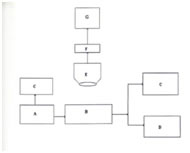Official Journals By StatPerson Publication
|
Table of Content - Volume 3 Issue 3 - September 2017
Bilirubin content and dielectrophoresis of erythrocytes of patients suffering from jaundice
Farha Isna1, Raisa Faheem2*, Kaleem Ahmed Jaleeli3
1,2Assistant Professor, Department of Biochemistry, Daccan College of Medical Sciences, Hyderabad, Telangana, INDIA. 3Biophysics Research Laboratory, Department of Physics, Nizam College, Osmania University, Hyderabad, Telangana, INDIA. Email: dr_faheem2004@yahoo.co.uk
Abstract The paper reports the dielectrophoretic behaviour of erythrocytes of blood of the patients suffering from jaundice. The erythrocytes suspended in isotonic solution were subjected to non-uniform electric field produced by spherical field geometry. For this purpose, a pin-pin electrode chamber was constructed in the Laboratory. The parameters dielectrophoretic collection rate (DCR) and threshold voltage (Vth) were measured experimentally at constant cell concentration, frequency and voltage of applied field for normal and diseased blood. The study reveals significant differences in dielectrophoretic collection rate and threshold voltage of erythrocytes of diseased patients, when compared with that of healthy persons. The relations between DCR or Vth and known concentrations of billirubin are established. Key Words: Billirubin, Erythrocytes, Dielectrophoretic collection rate and Threshold Voltage.
INTRODUCTION Jaundice is the disease when excessive bile pigment is formed and escapes into tissue causing it yellow in colour. This condition is due to malfunctioning of either liver or gall bladder. There exist biochemical tests to measure billirubin concentration in order to evaluate degree of infection caused to liver or gall bladder. Alternatively, there can be physical methods. Dielectrophoretic technique serves the purpose. In this paper, erythrocytes of normal and diseased (Jaundice) blood are subjected to non uniform alternating electric field of frequency 1 MHz, produced by pin – pin electrode configuration. The study was taken up for 414 neonates, the mean total bilirubin on admission was 19.7±8.16mg percent and the mean age was 4.9 ± 4.2 days. It has been concluded that high incidence can be reduced by early referral, percentage of infection, and reduction of preterm births by improved antenatal case and nutrition. Bilirubin concentration between and thalassania carriers has been investigated1. The difference in bilirubin concentration between and thalassamia heterozygotes may be attributed to more bilirubin being produce in thalassamia hetrozygotes than in thalassamia heterozygotes. Pathophysiology of Jaundice was reported2. The study of non-uniform electric field effects on biological cells reveals the electrical make up of the basic unit of life. Visometric analysis of blood of patients suffering from thrombosis has been studied3. The results indicate that the viscosity of blood increases significantly due to thrombosis. Neonatal Jaundice in Pakistan has been reported4. Various causes and the mechanism involved in the occurrence of Jaundice were discussed. A perusal of literature reveals different methods and investigations for the diagnosis of Jaundice and other diseases but not much attention has been given to study the changes in RBC physiology of the blood drawn from the patients suffering from Jaundice at the membrane level. Therefore, an attempt has been made to study the alterations in RBC physiology of Jaundice blood by subjecting it to dielectrophoresis and determining DCR and Vth of normal and diseased erythrocytes.
MATERIALS AND METHODS
Figure 1: Diagram of dielecctrophoretic setup A: signal generator B: Electrode chamber C: Oscilloscope D: Digital frequency counter E: Microsccope F: Video camera G: Video monitor Fresh samples of normal blood of volume nearly 2 ml of different groups were collected from Asra Hospital, Hyderabad. The blood samples from the patients suffering from Jaundice were collected from Daccan college of medical sciences, Hyderabad. EDTA was used as an anti-coagulant. Red Blood cells of normal and diseased blood were isolated from plasma by centrifuging the blood at the rate of 1500 rpm for about 15 minutes. The cells were washed in isotonic glucine-glycose solution (2.1% glycine and 5.5% glucose in the volume ratio of 9:1). The packed cells, when washed, were then mixed with isotonic solution. The concentration of the cells was determined using red blood cell counting chamber and spectro colorimeter, with optical density as a guide. The experimental arrangement for cellular dielectrophoretic study has been mentioned elsewhere5.
RESULTS AND DISCUSSION Table 1: Presents the data on Dielectrophoretic collection rate (DCR) and threshold voltage (Vth) of erythrocytes of healthy persons and patients suffering from Jaundice for different billirubin content at 1 MHz frequency.
It is evident from the Table 1 that the magnitude of DCR for Jaundice is less and the threshold voltage is more in comparison with the normal blood at 1 MHz frequency. The study suggests that high concentration of billirubin in the blood when compared with the normal level seems to decrease the dielectric property of the erythrocyte. The present study demonstrates that the erythrocyte membrane physiology is influenced or in other words perturbed due to disease. The erythrocyte seems to behave as a very sensitive sensor to pick up signals and store them in its membrane due to which it may become less dielectric than normal erythrocyte due to Jaundice. The present study demonstrates that the erythrocytes membrane physiology is perturbed due to disease. The study suggests that high concentration of bilirubin in the blood when compared with the normal level seems to decrease the dielectric property of the erythrocytes. The present investigation is mainly concerned with NUEF and its interaction with human erythrocytes in order to understand how electrical properties of erythrocytes from patients suffering from jaundice are influenced by the disease. For this purpose, dynamic dielectrophoretic technique has been adopted and the minimum voltage for the collection of erythrocytes at the electrode, called the threshold voltage has been measured at the frequency of 1 MHz.
REFERENCES
|
 Home
Home

